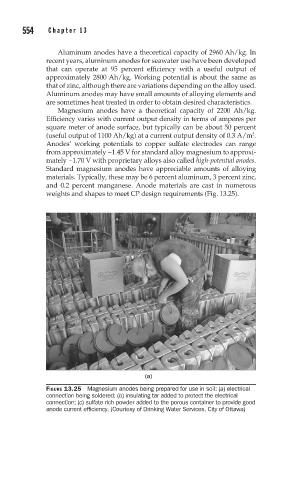Page 591 - Corrosion Engineering Principles and Practice
P. 591
554 C h a p t e r 1 3 C a t h o d i c P r o t e c t i o n 555
Aluminum anodes have a theoretical capacity of 2960 Ah/kg. In
recent years, aluminum anodes for seawater use have been developed
that can operate at 95 percent efficiency with a useful output of
approximately 2800 Ah/kg. Working potential is about the same as
that of zinc, although there are variations depending on the alloy used.
Aluminum anodes may have small amounts of alloying elements and
are sometimes heat treated in order to obtain desired characteristics.
Magnesium anodes have a theoretical capacity of 2200 Ah/kg.
Efficiency varies with current output density in terms of amperes per
square meter of anode surface, but typically can be about 50 percent
(useful output of 1100 Ah/kg) at a current output density of 0.3 A/m .
2
Anodes’ working potentials to copper sulfate electrodes can range
from approximately −1.45 V for standard alloy magnesium to approxi-
mately −1.70 V with proprietary alloys also called high-potential anodes.
Standard magnesium anodes have appreciable amounts of alloying
materials. Typically, these may be 6 percent aluminum, 3 percent zinc,
and 0.2 percent manganese. Anode materials are cast in numerous
weights and shapes to meet CP design requirements (Fig. 13.25).
(a)
FIGURE 13.25 Magnesium anodes being prepared for use in soil: (a) electrical
connection being soldered; (b) insulating tar added to protect the electrical
connection; (c) sulfate rich powder added to the porous container to provide good
anode current efficiency. (Courtesy of Drinking Water Services, City of Ottawa)

